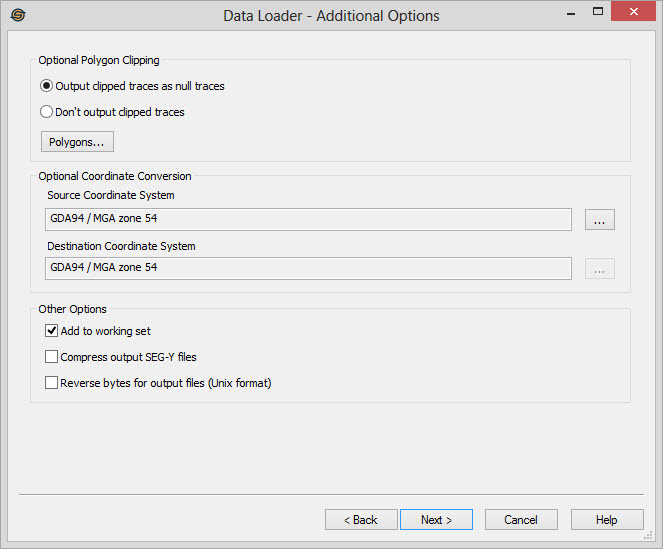Data Loader: Additional Options
Use this page to specify a variety of less commonly used functions of the data load.

Optional Polygon Clipping
You can clip the traces of the input file using predefined
polygons. This can be useful when you only want to import a
subset of you data.
Output
clipped traces as null
traces: Selecting this option will still import the
entire data
file, however traces that have been clipped will be written as traces
where all the samples have zero values.
Don't output clipped traces: Selecting this option will prevent any clipped traces from being written to the resulting output file.
Don't output clipped traces: Selecting this option will prevent any clipped traces from being written to the resulting output file.
Note: We cannot handle 3D
datasets that have holes in them. You will need to select Output clipped traces as null traces
to import these files.
Optional Coordinate Conversion
Use this option to convert the coordinates in the input file from one
coordinate system to another.
Source Coordinate System:Select the coordinate system of the input seismic by clicking
on
the "..." button. By default this is set to the coordinate
system
in the project
properties dialog. If you have obtained files with
a
different coordinate system from that of your project (such as a
neighboring UTM zone) you can set this value to automatically convert
the files to the project's coordinate system.
If you do not have a coordinate system defined for the project this area will initially be blank.
If you do not have a coordinate system defined for the project this area will initially be blank.
Destination Coordinate
System: Select a coordinate system for the loaded seismic by
clicking on
the "..." button. By default this is set to the coordinate
system
in the project
properties dialog. It is best to set this in the
project
properties rather than in this dialog.
If you do not have a coordinate system defined for the project this area will initially be blank. When converting between coordinate systems you need to set both the source and destination coordinate systems.
If you do not have a coordinate system defined for the project this area will initially be blank. When converting between coordinate systems you need to set both the source and destination coordinate systems.
Other Options
Specify other options for import.
Add to
working set: Make
the loaded files members of the working set. Normally you
will
set this to true, but sometimes you may not wish to override your
currently defined working set.
Note: If this is the first file for a given line (i.e. there is no working set defined for this line) the file will become a member of the working set even if this option is turned off.
Compress output SEG-Y files: Setting this option directs the operating system to write the file to disk as a compressed file. Use this to save disk space. Not all operating systems support compression so when writing to a network drive this option may be ignored.
Reverse bytes for output files (Unix format): Most Unix systems expect files to be stored with the opposite byte order, so if you intend to use the files on a Unix system you may want to check this option. PC files are typically stored in "Little Endian" format while traditional Unix systems store files in "Big Endian" format. We can read either format of file.
Note: If this is the first file for a given line (i.e. there is no working set defined for this line) the file will become a member of the working set even if this option is turned off.
Compress output SEG-Y files: Setting this option directs the operating system to write the file to disk as a compressed file. Use this to save disk space. Not all operating systems support compression so when writing to a network drive this option may be ignored.
Reverse bytes for output files (Unix format): Most Unix systems expect files to be stored with the opposite byte order, so if you intend to use the files on a Unix system you may want to check this option. PC files are typically stored in "Little Endian" format while traditional Unix systems store files in "Big Endian" format. We can read either format of file.
— MORE INFORMATION

|
Copyright © 2020 | SeisWare International Inc. | All rights reserved |